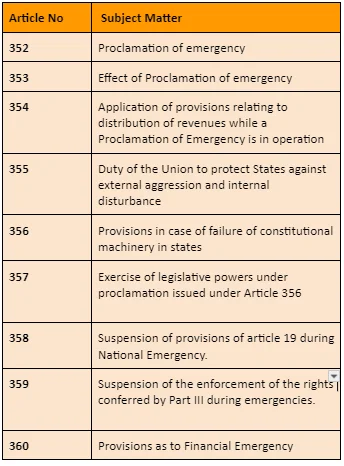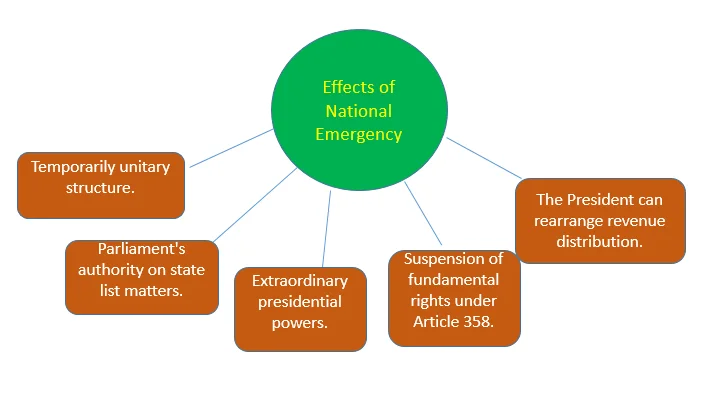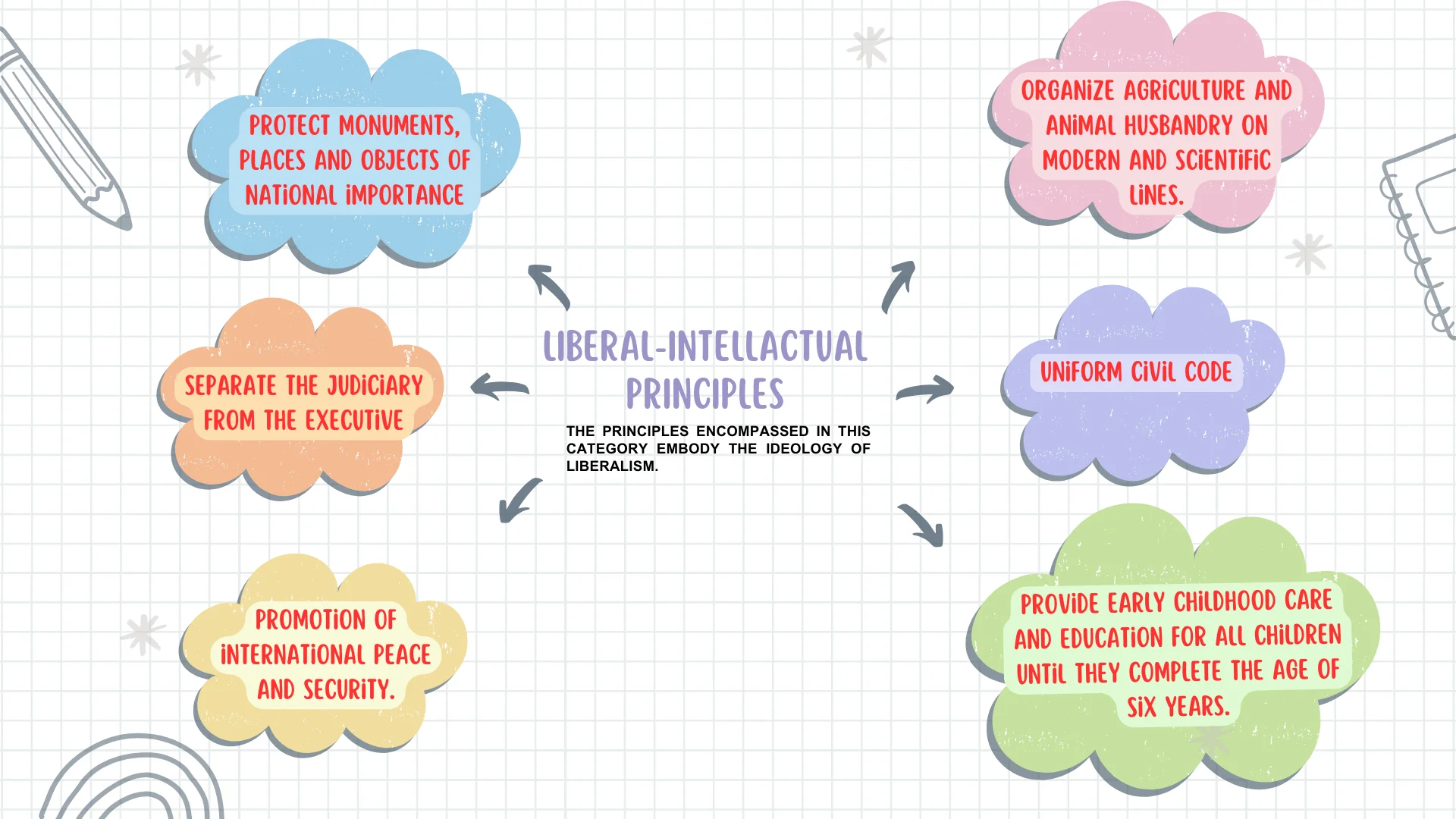Article 356, also known as President’s Rule, allows the Central government to take control of a state when its constitutional machinery fails. This is rooted in the Centre’s responsibility under Article 355 to protect states from external aggression and internal disturbances. President’s Rule has been imposed numerous times since 1950, often sparking controversy due to its political implications.
President’s Rule in India
Constitutional Provisions
- Article 352 Authority: Article 352 of the Indian Constitution grants the President the authority to declare a national emergency when the security of India or a portion of it faces threats from war, external aggression, or armed rebellion.

-
- Declaration of National Emergency: The President can declare a national emergency if they believe there is a serious threat to India’s security from war, external aggression, or armed rebellion.
- This declaration can cover the whole country or specific regions.
- Cabinet Approval Required: Before declaring a national emergency, the President must get written approval from the Union Cabinet, which includes the Prime Minister and other senior ministers.
- Parliamentary Oversight: Any emergency proclamation must be presented to both Houses of Parliament.
- If it is not approved within one month, the proclamation will expire unless it has been revoked beforehand.
- Declaration of National Emergency: The President can declare a national emergency if they believe there is a serious threat to India’s security from war, external aggression, or armed rebellion.
- Amendment by the 44th Act: The 44th Amendment Act of 1978 replaced the term ‘internal disturbance’ with ‘armed rebellion,’ effectively eliminating the possibility of declaring a National Emergency based on ‘internal disturbance.’
- Types of National Emergency:
- External Emergency: A National Emergency declared on the grounds of ‘war’ or ‘external aggression’ is referred to as an ‘External Emergency.’
- Internal Emergency: When a National Emergency is declared due to ‘armed rebellion,’ it is known as an ‘Internal Emergency.’
- Pre-emptive Declaration:
- The President can declare a National Emergency even in anticipation of war, external aggression, or armed rebellion if they are satisfied that there is an imminent danger.
- This provision allows the executive to proactively address impending crises.
- Changing or Ending the Proclamation: The President can modify or revoke the emergency declaration with another proclamation.
- Multiple Proclamations:
- The President can issue separate proclamations based on war, external aggression, armed rebellion, or imminent danger, regardless of whether an existing proclamation is in effect.
- This addition was introduced by the 38th Amendment Act of 1975.
- Scope of National Emergency:
- A proclamation of a National Emergency can apply to the entire country or only a specific part of it.
- The 42nd Amendment Act of 1976 empowered the President to restrict the operation of a National Emergency to a designated region within India.
Enroll now for UPSC Online Course
Article 352 and Judicial Review
|
Proclamation of National Emergency – Safeguards and Approval
Cabinet Recommendation: The President can declare a national emergency only upon receiving a written recommendation from the Cabinet.
- This ensures that the decision is made collectively by the Cabinet, rather than solely on the advice of the Prime Minister.
- The 44th Amendment Act of 1978 introduced this safeguard.
- In 1975, the then Prime Minister (Indira Gandhi) advised the President to proclaim an emergency and the cabinet came to know about it after it was made.
- Parliamentary Ratification: The proclamation of a national emergency must be ratified by both the Houses of the Parliament within one month from its issuance, as per the 44th Amendment Act of 1978.
-
- Originally, a two-month period was allowed for approval by the Parliament.
- Dissolution of Lok Sabha: If the Lok Sabha is dissolved at the time of the emergency declaration or during the one-month period without approving the proclamation, it remains in effect until 30 days from the first sitting of the reconstituted Lok Sabha, provided the Rajya Sabha has approved it in the meantime.
- Duration and Extension: After approval by both the Houses, the national emergency continues for six months from the date of passage of the proclamation in the second house and can be extended indefinitely with Parliament’s approval every six months, a provision also introduced by the 44th Amendment Act of 1978.
- Special Majority: All resolutions related to national emergency must be passed by a special majority, that is a majority of the total membership of the house and by a majority of not less than two-thirds of the members of the house present and voting.
- This special majority provision was introduced by the 44th Constitutional Amendment Act of 1978.
Revocation of National Emergency
- President’s Proclamation: A proclamation of Emergency may be revoked by the President at any time by a subsequent proclamation.
- Such a proclamation does not require parliamentary approval.
- Moreover, the President must revoke a proclamation if a resolution disapproving the proclamation is passed by the Lok Sabha.
- This provision of resolution by the Lok Sabha was added as a safeguard by the 44th Amendment Act of 1978.
- Before the amendment the Lok Sabha had no say in this regard.
- Initiation of Discontinuation Proceedings: The Lok Sabha holds the authority to initiate the process of discontinuing a national emergency.
- Written Notice Requirement: To initiate this process, Lok Sabha members must submit a written notice, signed by no less than one-tenth of the total members(added by the 44th Amendment Act of 1978), indicating their intent to propose a resolution for ending the emergency.
- Recipient of the Resolution: The resolution, intended to terminate the emergency, should be directed either to the Speaker if the Lok Sabha is in session or to the President if the House is not in session.
- Mandatory Special Session: Upon receiving the notice, a special sitting of the Lok Sabha is mandated to be convened within 14 days from the date of notice submission .
- This special session is specifically for the purpose of deliberating on the resolution to terminate the emergency.
- Majority Vote Requirement: For the resolution to be successful in discontinuing the emergency, it needs to secure a simple majority vote in the Lok Sabha.
- A simple majority means more members voting in favor than against.
- Reinvocation Possibility: It’s important to note that even if the Lok Sabha successfully passes a resolution to discontinue the emergency, the President can reinstate it if advised by the Council of Ministers.
- The emergency can thus be reinvoked based on their recommendations.
Effects of National Emergency

Effect on Centre-State Relations
- Executive Changes: During a National Emergency, the Centre can issue directives to any state on “any” matter, effectively placing state governments under its control, although they are not suspended.
- In normal times, the centre can give executive directions to a state only on specific matters.
- Legislative Impact:
- The Parliament gains the power to make laws on subjects in the State List. While state legislatures retain their legislative authority, it is subject to the overriding supremacy of the Parliament.
- This shift temporarily transforms the Constitution from federal to a unitary system during the emergency.
- Laws passed by Parliament on state subjects become inoperative six months after the emergency ends.
- If the Parliament is not in session, the President can issue ordinances on the state subjects also during the proclamation of national emergency.
- The Parliament can give powers to the Centre or its authorities to carry out the laws (even for matters outside the Union List) made by it under its extended jurisdiction.
- Extension of Ordinance-Making and Conferment of Power Provisions: The two provisions of the ordinance making and the conferment of power to the Centre can be extended to other parts of the country beyond the state where the Emergency is in operation.
- This was added by the 42nd Amendment Act of 1976.
- Extension of Ordinance-Making and Conferment of Power Provisions: The two provisions of the ordinance making and the conferment of power to the Centre can be extended to other parts of the country beyond the state where the Emergency is in operation.
- Revenue Alteration (Article 354):
-
- The President can modify the distribution of revenues between the Centre and states during a national emergency.
- This may involve reducing or canceling financial transfers from the Centre to the states.
- These modifications persist until the end of the financial year in which the emergency ceases and requires approval by both the Houses of Parliament.
Effect on the Life of the Lok Sabha and State Assembly
- Extension of Terms:
-
- During a National Emergency, the life of the Lok Sabha (and State Assemblies) can be extended beyond their normal terms.
- The Parliament may pass a law to extend the term for one year at a time, multiple times
- But this extension ceases to continue beyond a period of six months after the emergency’s end.
Effect on Fundamental Rights
- Suspension of Fundamental Rights under Article 19:
-
-
- Article 358 automatically suspends the six Fundamental Rights under Article 19 when a national emergency is declared on the grounds of war or external aggression.
- The state is freed from restrictions on making laws or taking executive actions that infringe upon these Fundamental Rights during the emergency.
- When the emergency ends, Article 19 automatically revives, and any laws inconsistent with it cease to have effect.
- No remedy lies for anything done during the emergency even after the Emergency expires (can not be challenged in the court).
-
- Suspension of Other Fundamental Rights under Article 359:
-
- Article 359 authorizes the President to suspend the right to move any court for the enforcement of Fundamental Rights during a National Emergency.
- The 44th Constitutional Amendment ensured that rights under Article 20 and 21 remain enforceable.
- Only those Fundamental Rights specified in the Presidential Order are affected, and their enforcement, not the rights themselves, is suspended.
- The suspension can be for the emergency’s duration or a shorter period specified in the order and may apply to the whole or part of the country.
- These suspensions must be laid before each House of Parliament for approval.
The 44th Amendment Act of 1978 restricted the scope of these articles :
|
What are the differences between article 358 and article 359?
| Aspect | Article 358 | Article 359 |
|
|
|
|
|
|
|
|
|
|
|
|
|
|
|
Has there been any instance of declaration of National Emergency?
- National Emergency has been declared three times: in 1962, 1971, and 1975.
- First Declaration (1962)
- The first National Emergency was declared in October 1962 due to Chinese aggression in the North-East Frontier Agency (now Arunachal Pradesh).
- It remained in force until January 1968.
- This emergency obviate the need for a fresh declaration during the 1965 war with Pakistan.
- Second Declaration (1971)
- The second National Emergency was declared in December 1971 in response to an attack by Pakistan.
- Third Declaration (1975)
- The third National Emergency was declared in June 1975 on the grounds of “internal disturbance.”
- It was characterized by certain individuals inciting the police and armed forces against their normal duties.
- Both the 2nd and 3rd proclamations were revoked in 1977.
- Shah Commission Investigation
- The new government appointed the Shah Commission to investigate the circumstances that led to the declaration of the 1975 Emergency.
- The commission did not justify the Emergency declaration.
- Introduction of Safeguards (44th Amendment Act)
- In response to concerns about the misuse of Emergency provisions, the 44th Amendment Act was enacted in 1978.
- This amendment introduced several safeguards against the misuse of Emergency powers.

Enroll now for UPSC Online Course
| Must Read | |
| Current Affairs | Editorial Analysis |
| Upsc Notes | Upsc Blogs |
| NCERT Notes | Free Main Answer Writing |
Conclusion
President’s Rule is a significant constitutional mechanism for ensuring governance in states facing crises. Despite its critical role, the frequent and sometimes arbitrary use of Article 356 has led to debates on its implications for federalism in India.
- The Supreme Court’s rulings, especially in the Bommai case, have attempted to regulate and limit its misuse, highlighting the importance of maintaining constitutional balance and state autonomy.
Sign up for the PWOnlyIAS Online Course by Physics Wallah and start your journey to IAS success today!
| Related Articles | |
| 2024 Lok Sabha Elections | Article 352: National Emergency in India |
| Features of Indian Constitution | President’s Rule: Article 356 Explained |

 GS Foundation
GS Foundation Optional Course
Optional Course Combo Courses
Combo Courses Degree Program
Degree Program









